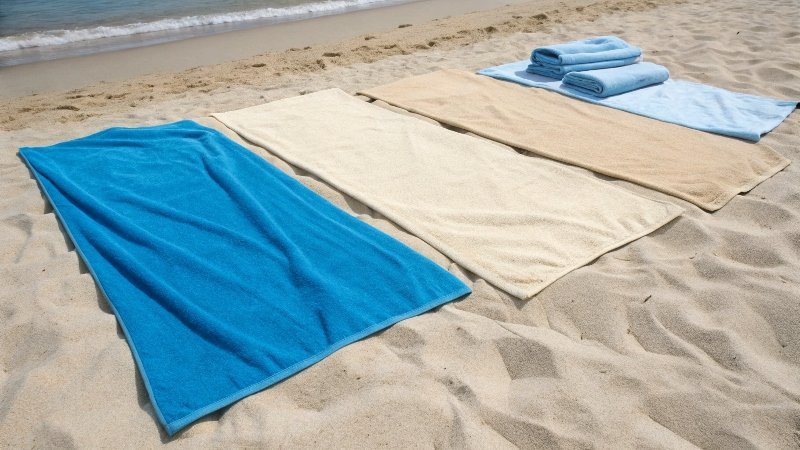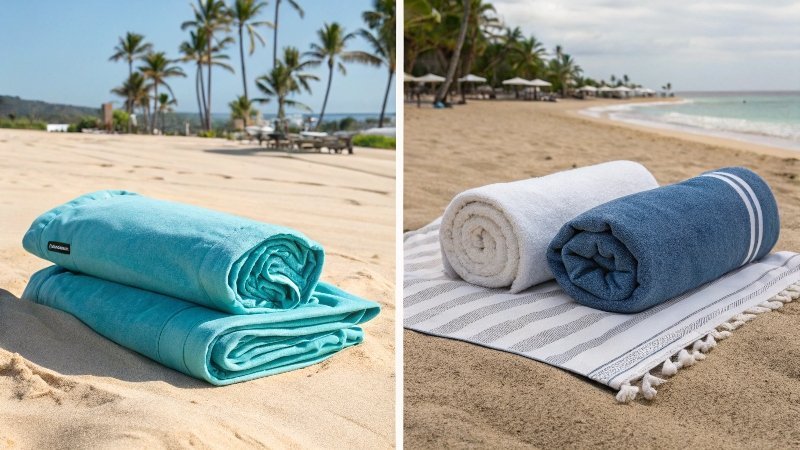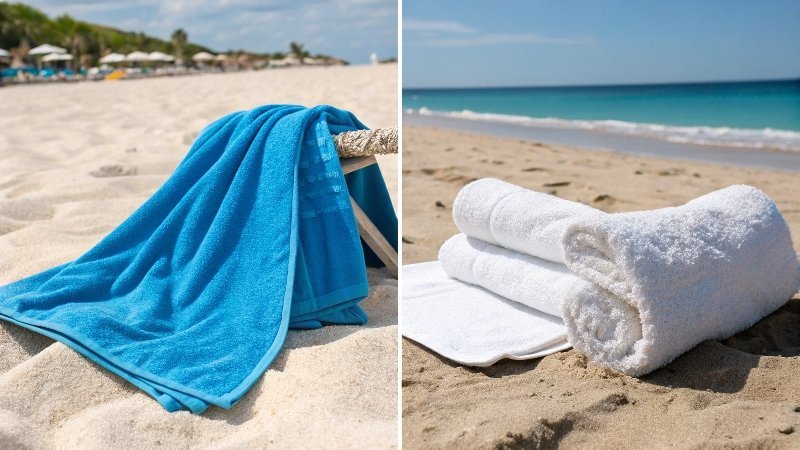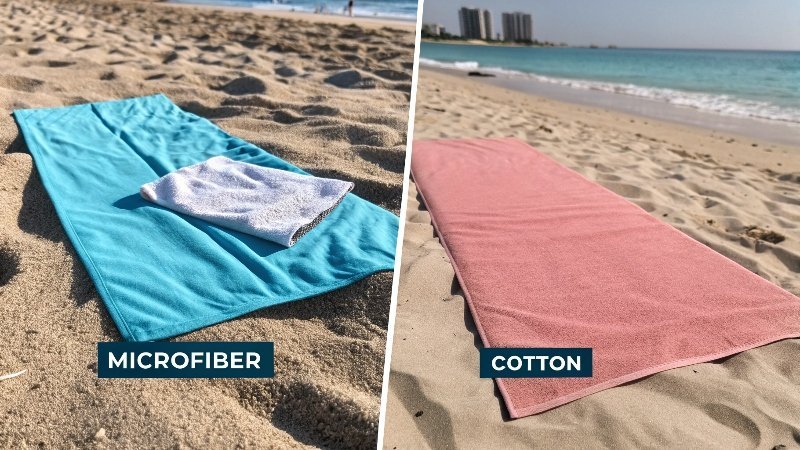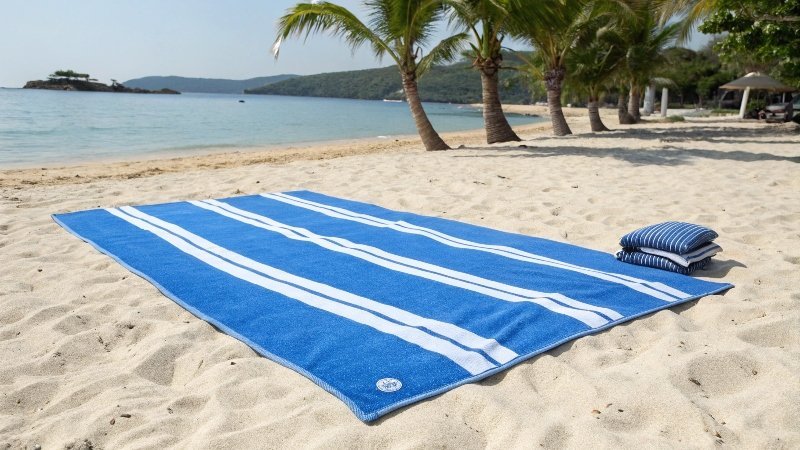Struggling to find a beach towel that doesn’t feel like a wet, sandy blanket after one use? Your perfect beach day deserves a better towel. Let’s fix that.
To choose the right beach towel, focus on three things: material, size, and purpose. Microfiber is best for travel as it’s quick-drying and sand-repellent. Cotton is plush and absorbent for lounging. A standard size of 80x160cm offers a great balance of coverage and portability.
Picking the right beach towel is about more than just a cool pattern. It’s a technical choice that can make or break your trip to the shore. As someone who has managed production for countless towel brands, I’ve seen what works and what doesn’t. To help you make a confident decision for your business or your own beach bag, we need to look closer at the details. Let’s break down the most important questions one by one.
What type of beach towel is best?
Are you overwhelmed by all the different towel types available? From classic fluffy towels to new high-tech options, it’s easy to get confused. Let me simplify it for you.
The best type of beach towel depends entirely on your needs. For travel and active use, quick-dry microfiber towels are superior. They are lightweight, compact, and shed sand easily. For pure luxury and poolside lounging, a traditional cotton terry towel provides unmatched softness and absorbency.
When I first started in this industry, cotton was king. But things have changed. The "best" type of towel is now a question of function over tradition. You have to match the towel’s features to the customer’s needs. I’ve helped so many brands navigate this choice, and it usually comes down to a few key options.
Classic Cotton Terry
This is the towel most of us grew up with. It’s thick, fluffy, and feels luxurious. The looped piles of cotton are excellent at soaking up water, making it great for drying off right after a swim. Its main drawback is performance. It gets heavy when wet, takes a very long time to dry, and traps sand in its fibers like a magnet.
Modern Microfiber
This is the top performer for the beach. Made from a blend of polyester and polyamide, microfiber towels are engineered to be lightweight and super absorbent, yet they dry incredibly fast. Sand doesn’t cling to the smooth surface, so a quick shake is all you need. They fold down to a fraction of the size of a cotton towel, making them a game-changer for packing.
Turkish Towels (Peshtemal)
Woven from flat Turkish cotton, these towels are stylish, lightweight, and versatile. They are more absorbent than they look and dry faster than terry cloth. While they don’t have the plush feel of traditional towels, they are great as a light cover-up or a blanket.
| Towel Type | Best For | Absorbency | Dry Time | Portability |
|---|---|---|---|---|
| Cotton Terry | Poolside Lounging, Luxury | Excellent | Very Slow | Poor |
| Microfiber | Travel, Active Use, Families | Good | Very Fast | Excellent |
| Turkish Towel | Style, Multi-Use | Moderate | Fast | Excellent |
What is the best material for beach towels?
The material of your towel dictates its feel and function. Choosing the wrong one means you’re stuck with a towel that stays damp and heavy all day long. Let’s find the right material.
For all-around beach performance, microfiber is the best material. It offers a superior combination of quick-drying, lightweight, and sand-repellent properties. Cotton is a strong contender for its plush softness and high absorbency, but it is less practical for a day at the beach.
In our factory, we handle these materials every single day. I can tell you that the difference between them is scientific. It’s not just a matter of opinion; it’s about how the fibers are constructed and what that means for you at the beach. Understanding this is key to choosing a product that will get great reviews.
The Case for Cotton
Cotton is a natural fiber that is inherently thirsty. Its quality and plushness are often measured in Grams per Square Meter (GSM). A beach towel with 400-600 GSM feels soft and absorbent. It’s perfect for wrapping up in after a swim. However, that absorbency is also its weakness. Once it soaks up water, it holds onto it, becoming heavy and taking hours to dry in the sun. It’s a great material for a controlled environment like a hotel pool but less ideal for a dynamic beach setting.
The Power of Microfiber
Microfiber is a synthetic material, typically an 80/20 or 88/12 blend of polyester and polyamide. The fibers are split into ultra-thin strands, creating an enormous surface area. This structure allows it to absorb a surprising amount of water quickly. But unlike cotton, it doesn’t hold the water deep inside. The moisture wicks to the surface and evaporates rapidly. This is why it dries so fast and why sand can’t get trapped. For our private-label clients, another huge benefit is printability. The smooth surface of microfiber allows for vibrant, edge-to-edge photo-quality printing, which is very difficult to achieve on a thick cotton terry.
Is microfiber or cotton better for beach towels?
It’s the ultimate showdown: classic cotton versus modern microfiber. One feels fluffy and familiar, while the other is light and efficient. Choosing wrong can lead to a bag full of sand and dampness.
Microfiber is better than cotton for beach towels. It dries much faster, sand shakes off it completely, and it’s incredibly lightweight and compact for easy packing. While cotton is softer and more absorbent initially, it becomes heavy and impractical once wet, holding onto sand and moisture.
I remember a client, an up-and-coming Amazon seller, who was getting hammered with bad reviews on their premium cotton beach towels. The product was high quality, 600 GSM Egyptian cotton, but the feedback was always the same: "it’s too heavy," "takes all day to dry," and "brought half the beach home with me." They were frustrated because they had invested in what they thought was the best material.
We sat down and I walked them through the practical differences. We decided to launch a parallel line of microfiber towels. The key was to manage customer expectations in the product description. We were honest: it has a different, smoother feel than cotton, but its performance is unmatched for the beach. The microfiber line took off. The positive reviews flowed in, praising the exact features that make it superior: "dries in minutes," "so light in my bag," "sand just falls off." It was a powerful lesson. The "better" material depends entirely on the context of its use.
Here’s a direct comparison to make the choice clear:
| Feature | Microfiber | Cotton |
|---|---|---|
| Drying Speed | Very Fast (often under an hour) | Very Slow (can take hours) |
| Sand Resistance | Excellent (sand shakes off easily) | Poor (sand gets trapped in loops) |
| Portability | Excellent (lightweight & compact) | Poor (heavy & bulky) |
| Best For | Travel, sports, families, active use | Poolside lounging, luxury feel |
What’s a good size beach towel?
Are you tired of your feet hanging off the end of your towel? Or maybe your towel is so big it takes up your entire bag. Getting the size right is a simple but crucial detail.
A good, standard beach towel size is approximately 80 x 160 cm (about 31 x 63 inches). This size provides enough space for most adults to lie on comfortably while remaining easy to pack and carry. It strikes the perfect balance between coverage and convenience.
As a manufacturer, we produce towels in every imaginable dimension. We have standard specs, but we also get custom orders for everything from tiny kids’ towels to massive, shareable blankets. Through all of this, a clear winner has emerged for general-purpose use. The 80 x 160 cm size is our number one bestseller for private-label brands for a reason: it just works. It’s large enough to provide a personal space on the sand but not so large that it becomes a burden.
Of course, other sizes have their place. It’s all about matching the dimensions to the intended user and activity.
The Standard All-Rounder
As mentioned, 80 x 160 cm (31 x 63 inches) is the gold standard. It’s what most people picture when they think of a beach towel. It offers full-body coverage for lounging and is big enough to dry you off effectively. For any brand launching a new beach towel line, this is the safest and most popular size to start with.
Oversized and Family Options
Sizes like 100 x 180 cm (39 x 71 inches) or even larger are considered oversized. These are fantastic for couples who want to share, for families who need a basecamp on the sand, or simply for anyone who wants a more luxurious, spacious feel. The trade-off is obvious: they are bulkier and heavier, even in microfiber.
Travel and Kids’ Sizes
On the smaller end, you’ll find towels around 70 x 140 cm (27 x 55 inches). This is a common size for kids’ towels or for minimalist travelers who want to save every possible inch of space in their backpack.
| Size (cm & inches) | Best For | Pro | Con |
|---|---|---|---|
| 70 x 140 cm (27 x 55 in) | Kids, Ultra-light Travel | Highly portable | Limited space for adults |
| 80 x 160 cm (31 x 63 in) | Standard Adult Use | Perfect balance of size & portability | Not big enough to share |
| 100 x 180 cm (39 x 71 in) | Couples, Luxury Lounging | Maximum coverage and space | Can be bulky to carry |
Conclusion
Choosing the right beach towel is simple when you focus on function. For most people, a standard 80x160cm microfiber towel is the perfect choice for a hassle-free day at the beach.

